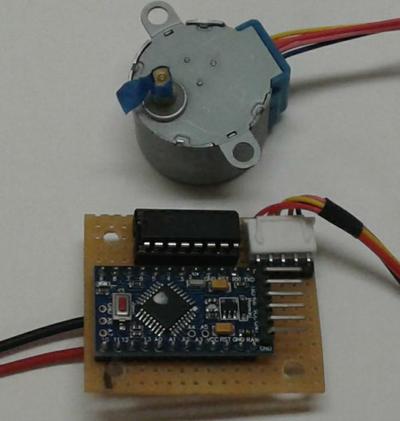If the top beacon fell off and touched the bulb, it would melt the lenses. So using an Arduino pro-mini and a commodity servo motor, I am going to attempt to modify a Marx tower to have the motor turn the beacon top and LED's light it. This should provide realistic action but no heat and much lower current draw. |

| I bought a package of 6 of them on Amazon for $12.99 and they came with the driver board which is the source of the ULN2003 chip I used. The motor has an integral gearbox that steps the speed down to about 1/64th of the motor speed. This increases the torque and if you choose the "20" set speed setting in the sketch below, it will turn about 10 times a minute which seems about right. Here is the CODE for the Arduino. |
|---|

| Initially I tried to power the LED's using the ladder for the negative side and the motor and shaft for the positive side. Unfortunately, because there are some bearings involved, it flickered quite a bit. I ended up using the ladder as negative but added a wire hidden behind the ladder as the positive for the LED's. That solved the flicker and the brightness is pretty good, not as bright as the original dimple bulb but plenty bright enough to be seen in regular room lighting. The arduino and driver chip are hidden in the little black box. I might detail it to look like some sort of electrical panel. The whole thing is powered off a 5 volt USB 1 Amp cell phone charger. It would be easy to create a simple circuit that would take the 18 volts AC from the standard Gilbert transformer. rectify it and drop it down to 5 volts DC. There are a lot of little modules available from Chinese suppliers on eBay that lend themselves to doing things like that for a couple of dollars. This is an older version using a Marx beacon. I ended up making a different version using a broken American Flyer 769 beacon and designed a new board that incorporates the rectifier and regulator so it will run off the standard 16 VAC transformer. A link to an early Youtube video where you can see it in operation Here |
|---|
|
| Rather than using an Atmega 328P chip and the support circuitry, I just used a whole Arduino Pro Mini. Again these are trivially cheap on eBay, about $3.50 I think. |
|---|